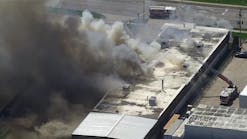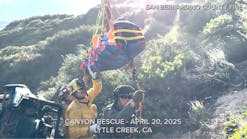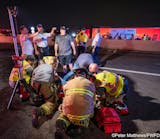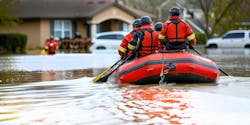Introduction
The National Fire Protection Association (NFPA) has produced a recommended standard that contains information of interest to extrication personnel. Known as NFPA 1670, Standard on Operations and Training for Technical Rescue Incidents, 1999 edition, the document became effective November 1998. In its 10 chapters, it identifies and establishes levels of functional capability for safely and effectively conducting operations at technical rescue incidents. Specifically, Chapter 6 focuses on vehicle and machinery rescue. This includes incidents involving cars, trucks, buses, trains, mass transit systems, aircraft, watercraft, agricultural implements, industrial/construction machinery and elevators or escalators.
NFPA 1670 establishes Awareness, Operations and Technician levels for vehicle and machinery rescue much like the field of hazardous material emergency response. Each level has its own capabilities as well as limitations.
At the Technician level, NFPA’s Standard 1670 requires vehicle-rescue personnel to be capable of completing advanced stabilization of unusual vehicle and/or machinery rescue situations. The Standard further explains that a car on its side is considered an “unusual” situation.
“Advanced stabilization,” as described in the NFPA Standard, involves techniques that use equipment such as rescue chains, cables, jack devices, and cribbing/shoring (NFPA 1670, 6-4.2b).
This University of Extrication column is the first of a multi-part series presenting advanced technician-level vehicle rescue training scenarios. Each article will describe an interesting and challenging vehicle rescue evolution that can be used in a training environment to challenge personnel with technician-level skills and competencies.
Jacking and Shoring of A Side-Resting Vehicle
To set up for this scenario, a vehicle must be placed on its side, preferably with the driver’s side down. The simulation is that a person is trapped beneath the door and the ground. The rescue team must lift the vehicle until the bottom door is eight inches off the ground to free the “patient.”
A four- to six-person team should be capable of accomplishing this task in 12 minutes or less. The strategy is to first stabilize the side-resting vehicle, and then accomplish the lift. The stabilization equipment must adjust to constantly maintain a secure and stable vehicle as the lift takes place.
The most effective stabilization tactic is to utilize a tensioned buttress stabilization system. Because the vehicle will be lifted, the struts should be placed at a slightly shallower angle than normal. Then, as the vehicle is lifted, the struts can be adjusted to assume a more correct stabilization angle. The strut system will also carry an increasing load as the weight of the vehicle shifts to them.
Stabilization during this lifting assignment is a nearly impossible task to accomplish utilizing only individual cribbing blocks. The cribbing is not as stable as a buttress system and the instability of any box crib puts all personnel at risk during the lift. Depending upon the resources available to the fire department, other stabilization tools and equipment can be used including chains, come-alongs, cables or winch lines, power rams, and long-length four-by-four-inch timbers. Consider this scenario also as an excellent opportunity to cross-train with your local towing-and-recovery company. Doing the job with your equipment and then doing it with the assistance of the local tow company can be a great training opportunity.
There are two lifting tactics that can be employed. One plan is to lift the entire vehicle off the ground the required eight inches. The vehicle remains level and balanced as the entire vehicle lifts off the ground from bumper to bumper. This effort will require multiple lifting points that all lift simultaneously. The second and more common lifting approach is to accomplish a tilting lift. With this plan, only one end of the vehicle is lifted while the opposite end remains in contact with the ground. The lifting must be enough to get the eight inches of clearance as measured at the center of the bottom door. The actual lifting is most commonly accomplished with rescue air bags either stacked or placed at multiple points along the underside of the vehicle. Tools such as power spreaders, power rams, mechanical jacks and hydraulic jacks can accomplish the lift also.
The team accomplishing this assignment must remain alert to safety concerns that can arise during their work. Obviously, vehicle stabilization is a primary concern. The less contact with the ground, the more unpredictable and unstable the vehicle can become. Assure that both sides of the vehicle are being monitored at all times. This can best be accomplished by positioning one person at either the front or the rear of the vehicle to watch for vehicle tilt or lean during the lift.
The lifting effort must be “balanced.” Because the vehicle is already on its side, any lift tool that isn’t lifting straight up can push the vehicle over or tip it to one side or the other. Be cautious with power spreaders. Remember, a spreader opens in an arc, not a straight line. If the arms are not properly placed beneath the load or if they are operated too far, they will exert an off-centered lift and cause instability of the vehicle.
Rescue personnel should never kneel when working this close to a lifted load. Always maintain a squat position. With this posture, if the load would shift or a tool slip or fail, you are in a better position to spring away from the hazard. If you are kneeling, you’ll be trapped!
TASK: Given the scenario of a side-resting vehicle with a simulated person trapped between the bottom door and the ground, lift the vehicle a distance of eight inches off the ground as measured at a point at the center of the bottom door, stabilize the vehicle in the lifted position and remove the lifting equipment.
Ron Moore, a Firehouse® contributing editor, is a battalion chief and the training officer for the McKinney, TX, Fire Department. He also authors a monthly online article in the Firehouse.com “MembersZone” and serves as the Forum Moderator for the extrication section of the Firehouse.com website. Moore can be contacted directly at [email protected].








